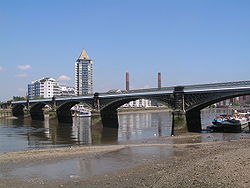
Battersea is a large district in southwest London, part of the London Borough of Wandsworth, England. It is centred 3.5 miles (5.6 km) southwest of Charing Cross it also extends along the south bank of the Thames Tideway. It includes the 200-acre (0.81 km2) Battersea Park.

Wandsworth is a London borough in South West London, England. It forms part of Inner London and has an estimated population of 329,677 inhabitants. Its main named areas are Battersea, Balham, Putney, Tooting and Wandsworth Town.

Battersea Bridge is a five-span arch bridge with cast-iron girders and granite piers crossing the River Thames in London, England. It is situated on a sharp bend in the river, and links Battersea south of the river with Chelsea to the north. The bridge replaced a ferry service that had operated near the site since at least the middle of the 16th century.

Chelsea Bridge is a bridge over the River Thames in west London, connecting Chelsea on the north bank to Battersea on the south bank, and split between the City of Westminster, the London Borough of Wandsworth and the Royal Borough of Kensington and Chelsea. There have been two Chelsea Bridges, on the site of what was an ancient ford.

The West London line (WLL) is a short railway in inner West London that links Willesden Junction in the north to Clapham Junction in the south. The line has always been an important cross-London link, especially for freight services. Southern and London Overground provide regular passenger services; detailed below.

Battersea was a railway station on the West London Extension Railway located on Battersea High Street in Battersea, south-west London. Built at the request of the parishioners of Battersea, it opened on 2 March 1863. To prevent overloading the embankment, it was built of wood, with brick pillars under the platforms and structures, but was laid with broad gauge track, because the WLER carried GWR trains. It closed on 14 September 1940 or 21 October 1940 after air raid damage during the Blitz of World War II.

Albert Bridge is a road bridge over the River Thames connecting Chelsea in Central London on the north bank to Battersea on the south. Designed and built by Rowland Mason Ordish in 1873 as an Ordish–Lefeuvre system modified cable-stayed bridge, it proved to be structurally unsound, so between 1884 and 1887 Sir Joseph Bazalgette incorporated some of the design elements of a suspension bridge. In 1973 the Greater London Council added two concrete piers, which transformed the central span into a simple beam bridge. As a result, today the bridge is an unusual hybrid of three different design styles. It is an English Heritage Grade II* listed building.

Wandsworth Bridge crosses the River Thames in west London. It carries the A217 road between the area of Battersea, near Wandsworth Town Station, in the London Borough of Wandsworth on the south of the river, and the areas of Sands End and Parsons Green, in the London Borough of Hammersmith and Fulham, on the north side.

Richmond Railway Bridge in Richmond, south-west London, crosses the River Thames immediately upstream of Twickenham Bridge. It carries National Rail services operated by South Western Railway (SWR) on the Waterloo to Reading Line, and lies between Richmond and St. Margarets stations. The bridge was amongst the first railway crossings of the Thames.
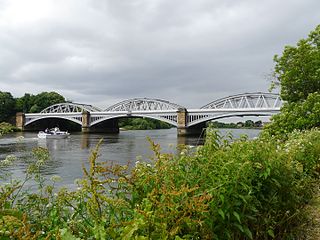
Barnes Railway Bridge is a Grade II listed railway bridge in the London Borough of Richmond upon Thames and the London Borough of Hounslow. It crosses the River Thames in London in a northwest to southeast direction at Barnes. It carries the South Western Railway's Hounslow Loop Line, and lies between Barnes Bridge and Chiswick stations. It can also be crossed on foot, and is one of only three bridges in London to combine pedestrian and rail use; the others being Hungerford Bridge and Golden Jubilee Bridges and Fulham Railway Bridge.

Windsor Railway Bridge is a wrought iron 'bow and string' bridge in Windsor, Berkshire, crossing the River Thames on the reach between Romney Lock and Boveney Lock. It carries the branch line between Slough and Windsor.
The West End of London and Crystal Palace Railway (WELCPR) was an early railway company in south London between Crystal Palace station and Wandsworth, which was opened in 1856. The line was extended in 1858 to Pimlico station at Battersea Wharf, near the bridge to Pimlico. Throughout its brief existence the railway was operated by the London Brighton and South Coast Railway (LB&SCR) to which it was leased in 1858 and sold in 1859. This relatively short line was of considerable importance to the history of railways of south London as it was the first line to create a corridor from the south and east towards Westminster and led to the development of London Victoria railway station.
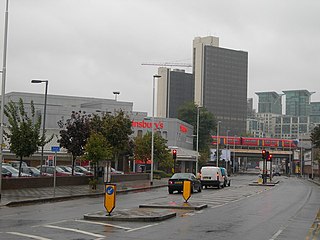
The A3036 is an A road in London, England, running from Waterloo to Wandsworth.

King's Road Chelsea railway station is a proposed station on Crossrail 2, a planned underground railway line through London in the United Kingdom. If constructed, the station would serve the King's Road area of Chelsea.
The West London Railway was conceived to link the London and Birmingham Railway and the Great Western Railway with the Kensington Basin of the Kensington Canal, enabling access to and from London docks for the carriage of goods. It opened in 1844 but was not commercially successful.

The North Wales Mineral Railway was formed to carry coal and ironstone from the mineral-bearing area around Wrexham to the River Dee wharves. It was extended to run from Shrewsbury and formed part of a main line trunk route, under the title The Shrewsbury and Chester Railway. It opened in 1846 from Chester to Ruabon, and in 1848 from Ruabon to Shrewsbury. It later merged with the Great Western Railway.
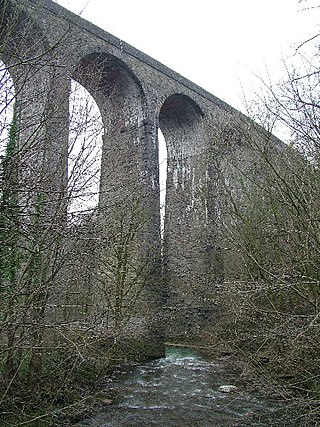
Hengoed Viaduct is a disused railway viaduct located above the village of Maesycwmmer, in Caerphilly county borough, South Wales. Grade II* listed, it was originally built to carry the Taff Vale Extension of the Newport, Abergavenny and Hereford Railway (NA&HR) across the Rhymney River, and is now part of National Cycle Route 47.

This article deals with the development of the London suburban railway lines of the London and South Western Railway (LSWR). For the wider view of the LSWR in general, see London and South Western Railway.
The Cremorne Footbridge is a proposed foot and cycle bridge over the Thames in London, England. It was originally promoted as the Diamond Jubilee Footbridge, designed by One World Design Architects with structural engineers Expedition Engineering and maritime engineers Beckett Rankine. The longer name commemorates the 2012 jubilee celebrations for Queen Elizabeth II, marking where she boarded her royal barge for the start of the Diamond Jubilee river pageant.
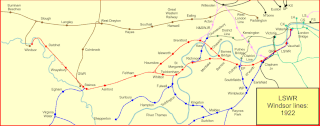
The Windsor lines of the London and South Western Railway ran from Waterloo to Windsor via Richmond, with a loop via Hounslow. They started as the Richmond Railway, a simple independent branch line, but they developed a distinct identity and had their own approach to Waterloo alongside the Main Lines, and a distinct section of Waterloo station. The Richmond Railway was extended to Windsor by the Windsor, Staines and South Western Railway; the company built a loop line via Hounslow in addition. Both independent companies were absorbed into the LSWR.
